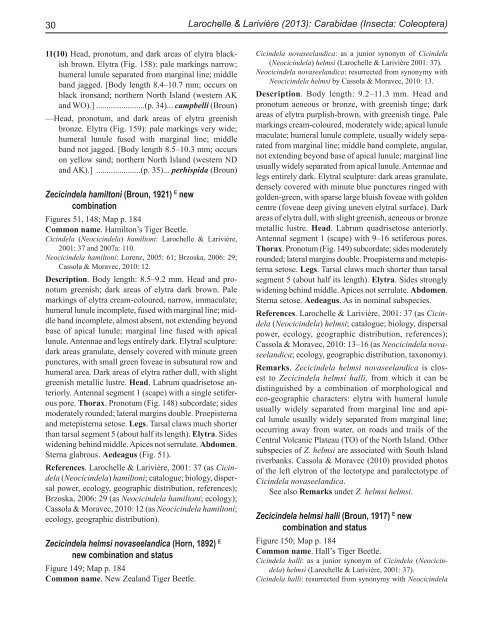Fauna of New Zealand 69 - Landcare Research
Fauna of New Zealand 69 - Landcare Research
Fauna of New Zealand 69 - Landcare Research
You also want an ePaper? Increase the reach of your titles
YUMPU automatically turns print PDFs into web optimized ePapers that Google loves.
30<br />
11(10) Head, pronotum, and dark areas <strong>of</strong> elytra blackish<br />
brown. Elytra (Fig. 158): pale markings narrow;<br />
humeral lunule separated from marginal line; middle<br />
band jagged. [Body length 8.4–10.7 mm; occurs on<br />
black ironsand; northern North Island (western AK<br />
and WO).] .......................(p. 34)... campbelli (Broun)<br />
—Head, pronotum, and dark areas <strong>of</strong> elytra greenish<br />
bronze. Elytra (Fig. 159): pale markings very wide;<br />
humeral lunule fused with marginal line; middle<br />
band not jagged. [Body length 8.5–10.3 mm; occurs<br />
on yellow sand; northern North Island (western ND<br />
and AK).] .....................(p. 35)... perhispida (Broun)<br />
Zecicindela hamiltoni (Broun, 1921) E new<br />
combination<br />
Figures 51, 148; Map p. 184<br />
Common name. Hamilton’s Tiger Beetle.<br />
Cicindela (Neocicindela) hamiltoni: Larochelle & Larivière,<br />
2001: 37 and 2007a: 110.<br />
Neocicindela hamiltoni: Lorenz, 2005: 61; Brzoska, 2006: 29;<br />
Cassola & Moravec, 2010: 12.<br />
Description. Body length: 8.5–9.2 mm. Head and pronotum<br />
greenish; dark areas <strong>of</strong> elytra dark brown. Pale<br />
markings <strong>of</strong> elytra cream-coloured, narrow, immaculate;<br />
humeral lunule incomplete, fused with marginal line; middle<br />
band incomplete, almost absent, not extending beyond<br />
base <strong>of</strong> apical lunule; marginal line fused with apical<br />
lunule. Antennae and legs entirely dark. Elytral sculpture:<br />
dark areas granulate, densely covered with minute green<br />
punctures, with small green foveae in subsutural row and<br />
humeral area. Dark areas <strong>of</strong> elytra rather dull, with slight<br />
greenish metallic lustre. Head. Labrum quadrisetose anteriorly.<br />
Antennal segment 1 (scape) with a single setiferous<br />
pore. Thorax. Pronotum (Fig. 148) subcordate; sides<br />
moderately rounded; lateral margins double. Proepisterna<br />
and metepisterna setose. Legs. Tarsal claws much shorter<br />
than tarsal segment 5 (about half its length). Elytra. Sides<br />
widening behind middle. Apices not serrulate. Abdomen.<br />
Sterna glabrous. Aedeagus (Fig. 51).<br />
References. Larochelle & Larivière, 2001: 37 (as Cicindela<br />
(Neocicindela) hamiltoni; catalogue; biology, dispersal<br />
power, ecology, geographic distribution, references);<br />
Brzoska, 2006: 29 (as Neocicindela hamiltoni; ecology);<br />
Cassola & Moravec, 2010: 12 (as Neocicindela hamiltoni;<br />
ecology, geographic distribution).<br />
Zecicindela helmsi novaseelandica (Horn, 1892) E<br />
new combination and status<br />
Figure 149; Map p. 184<br />
Common name. <strong>New</strong> <strong>Zealand</strong> Tiger Beetle.<br />
Larochelle & Larivière (2013): Carabidae (Insecta: Coleoptera)<br />
Cicindela novaseelandica: as a junior synonym <strong>of</strong> Cicindela<br />
(Neocicindela) helmsi (Larochelle & Larivière 2001: 37).<br />
Neocicindela novaseelandica: resurrected from synonymy with<br />
Neocicindela helmsi by Cassola & Moravec, 2010: 13.<br />
Description. Body length: 9.2–11.3 mm. Head and<br />
pronotum aeneous or bronze, with greenish tinge; dark<br />
areas <strong>of</strong> elytra purplish-brown, with greenish tinge. Pale<br />
markings cream-coloured, moderately wide; apical lunule<br />
maculate; humeral lunule complete, usually widely separated<br />
from marginal line; middle band complete, angular,<br />
not extending beyond base <strong>of</strong> apical lunule; marginal line<br />
usually widely separated from apical lunule. Antennae and<br />
legs entirely dark. Elytral sculpture: dark areas granulate,<br />
densely covered with minute blue punctures ringed with<br />
golden-green, with sparse large bluish foveae with golden<br />
centre (foveae deep giving uneven elytral surface). Dark<br />
areas <strong>of</strong> elytra dull, with slight greenish, aeneous or bronze<br />
metallic lustre. Head. Labrum quadrisetose anteriorly.<br />
Antennal segment 1 (scape) with 9–16 setiferous pores.<br />
Thorax. Pronotum (Fig. 149) subcordate; sides moderately<br />
rounded; lateral margins double. Proepisterna and metepisterna<br />
setose. Legs. Tarsal claws much shorter than tarsal<br />
segment 5 (about half its length). Elytra. Sides strongly<br />
widening behind middle. Apices not serrulate. Abdomen.<br />
Sterna setose. Aedeagus. As in nominal subspecies.<br />
References. Larochelle & Larivière, 2001: 37 (as Cicindela<br />
(Neocicindela) helmsi; catalogue; biology, dispersal<br />
power, ecology, geographic distribution, references);<br />
Cassola & Moravec, 2010: 13–16 (as Neocicindela novaseelandica;<br />
ecology, geographic distribution, taxonomy).<br />
Remarks. Zecicindela helmsi novaseelandica is closest<br />
to Zecicindela helmsi halli, from which it can be<br />
distinguished by a combination <strong>of</strong> morphological and<br />
eco-geographic characters: elytra with humeral lunule<br />
usually widely separated from marginal line and apical<br />
lunule usually widely separated from marginal line;<br />
occurring away from water, on roads and trails <strong>of</strong> the<br />
Central Volcanic Plateau (TO) <strong>of</strong> the North Island. Other<br />
subspecies <strong>of</strong> Z. helmsi are associated with South Island<br />
riverbanks. Cassola & Moravec (2010) provided photos<br />
<strong>of</strong> the left elytron <strong>of</strong> the lectotype and paralectotype <strong>of</strong><br />
Cicindela novaseelandica.<br />
See also Remarks under Z. helmsi helmsi.<br />
Zecicindela helmsi halli (Broun, 1917) E new<br />
combination and status<br />
Figure 150; Map p. 184<br />
Common name. Hall’s Tiger Beetle.<br />
Cicindela halli: as a junior synonym <strong>of</strong> Cicindela (Neocicindela)<br />
helmsi (Larochelle & Larivière, 2001: 37).<br />
Cicindela halli: resurrected from synonymy with Neocicindela
















